
Создание анимированных титров к фильму Taare Zameen Par
23.02.2015
Создание заглавных титров в технике пластилиновой анимации художником Дхимантом Вьясом (Dhimant Vyas) и его командой.
Making of Taare Zameen Par title animation

This video shows all the details of making of TZP title. It was shot by Arvind while I was shooting.
Why clay animation? After the completion of the film, the sequences where animation was to be used were planned. They were mostly dream sequences, where the boy is lost in his own world of fantasy. There are many transitions from one fantasy to the other. Aamir did not want to use human characters in the animation. He wanted elements from nature - fish, animals, birds, plants, flowers and so on. Various kinds of samples were created and he liked the clay animation. There is a certain tactile quality to this technique. As children play with plasticine or modelling clay, it became more of an obvious choice. There is an organic feel to the medium, which is not achievable through computer-generated animation. Clay is something that everyone can relate to easily.


For some of the transitions we made replacements models and used them to speed up the actual animation process like in the scene where the peacock turns into a flower, Watermelon turns into Moon etc Instead of modeling and animating directly on the table.
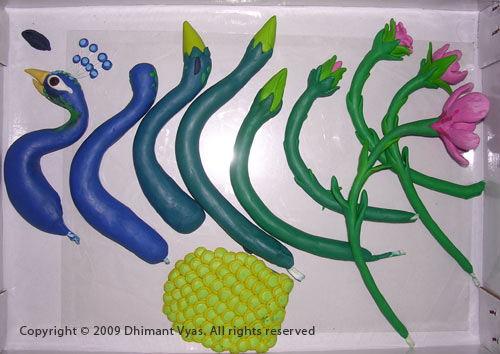

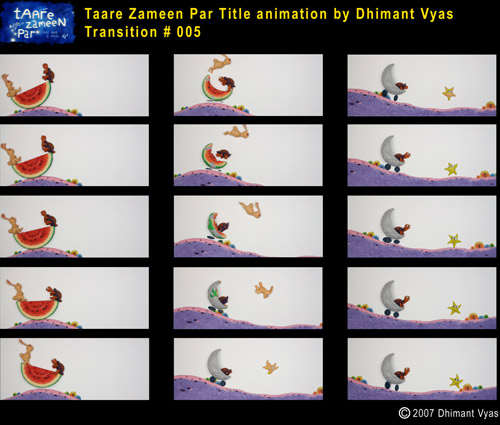
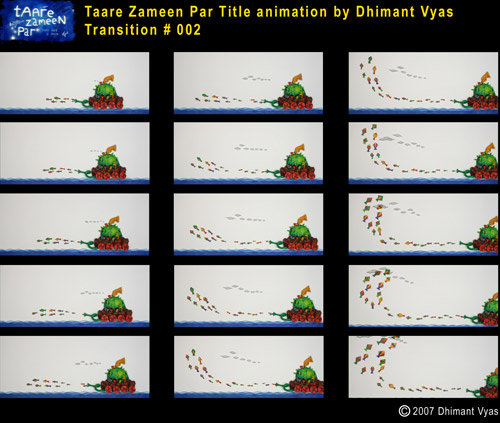

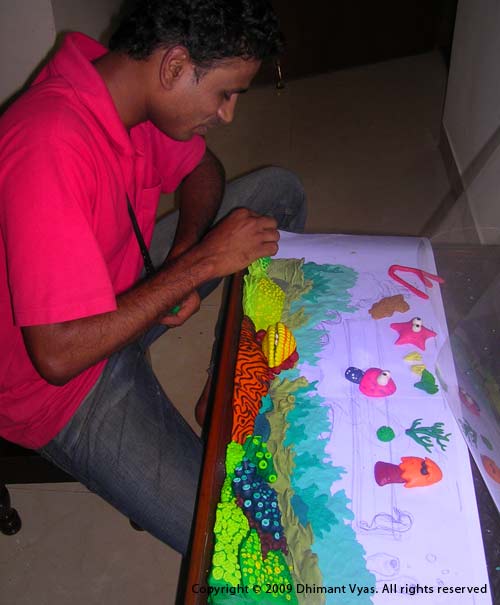
Vishal making under water Back ground

Arvind busy making Pizza Planet
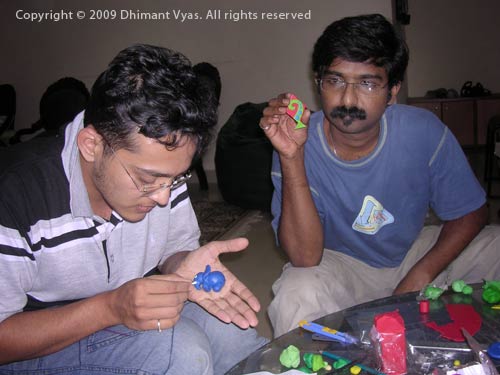
Harshad detailing the elephant, Arvind with his miniature kite
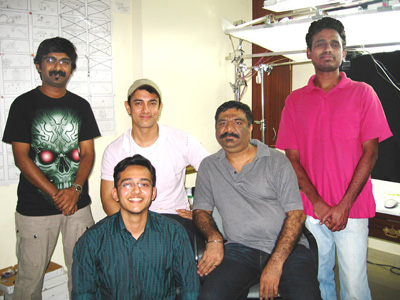
Arvind Chudasama, Aamir Khan, Dhimant Vyas, Vishal Mhala, Harshad Godbole (in front)
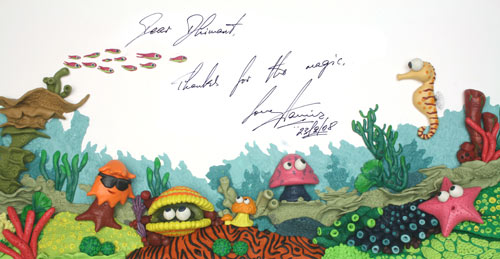
‘Dear Dhimant, Thanks for the magic, Love - Aamir 23/ 08/ 2008’
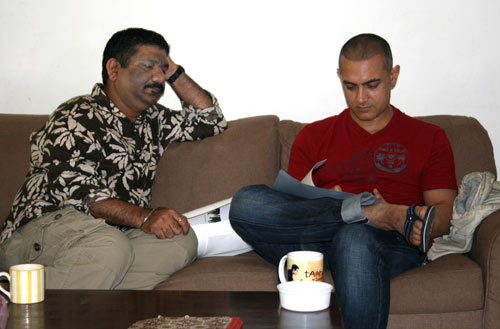
Dhimant Vyas and Aamir khan

Dhimant Vyas and Aamir khan
Dhimant Vyas, dhimantvyas.com
Interview with Dhimant Vyas - The making of TZP’s clay animation
January 17, 2008
We (AAA - allaboutanimation.com) present the transcript of the chat we had with Dhimant Vyas about the making of the clay animation sequences in Taare Zameen Par. Hope you enjoyed the photographs we posted earlier. You can send your feedback and comments to Dhimant directly by sending him an email at dhimantvyas@rediffmail.com.
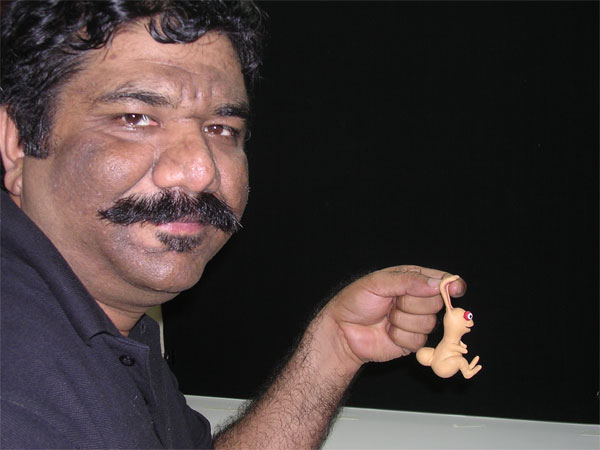
First of all, congratulations on being the first animator to use Clay animation in a Bollywood live-action feature film. How has the response been?
Yes, the response is overwhelming and very positive!! Thanks to Aamir for choosing the clay animation style. It is a craft with a human touch to it so it also tugs at the audience’s heartstrings. It works well with the main film because the story needed this kind of feel to it. The scenes depict Ishaan, the main protagonist’s imagination so the transitions had to be smooth scene and convey the dream-like quality. we used transitions like morphs, camera moves, elements appearing and disappearing, or you have one element dragging you to anther scene, so there is not cut till the end. And you do not realize when the three minutes pass by.
How did this project come about?
I had created the caricatures for the Lagaan DVD (Special Anniversary Edition Three Disc DVD box) I had shown Aamir some of my work which he had really appreciated. So when he decided to use animation for TZP, he approached me. Aamir initially wanted to use the classical animation style with a painterly quality. I suggested we try the clay animation technique. I showed him some samples. He liked it a lot and we decided to go ahead with clay animation.
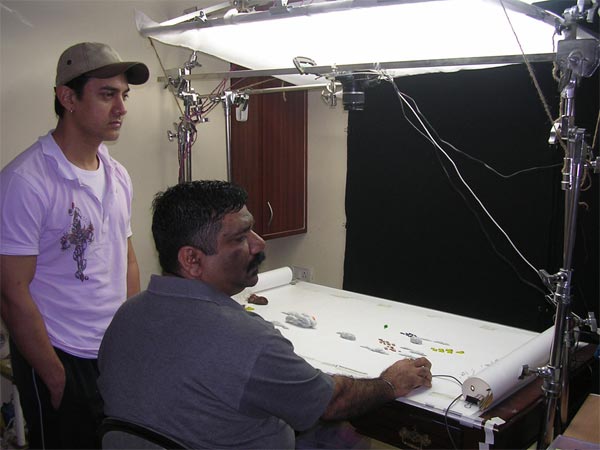
Why clay animation?
Aamir showed me the completed film and we discussed the use of animation. The sequences where we planned to use animation were mostly dream sequences, where the boy is lost in his own world of fantasy. There are a lot of transitions from one fantasy to the other. Aamir did not want to use human characters in the animation. He wanted elements from nature - fish, animals, birds, plants, flowers and so on. I created a few samples for him of which he liked the clay animation the best. There is a certain tactile quality to this technique. As children, all of us have played with plastecine or modelling clay and thoroughly enjoyed ourselves. There is an organic feel to the medium which is not achievable through computer generated animation. Clay is something that everyone can relate to it easily.
But the animation doesn’t come across as ‘childish’ in the film as it is film about children.
No. Aamir made it very clear that though it is part of the protagonist child’s imagination, there must be no childishness to the animation. He wanted a beautiful and polished effect which we tried our best to deliver. The elements are bright and colourful, just the way a child’s world is but it flows smoothly into the story. It is not animation just for the sake of animating something. There is a purpose and that is to carry the story forward. It is a subtle way of giving the audience a glimpse into the child’s inner world and the animation captures that perfectly.

Aamir is known to be a hard task master. How has the experience of working with him been?
Aamir’s thinking is crystal clear. He knows what he is looking for and conveys it exactly. It is up to us to realize his vision. He is a perfectionist but at the same time he respected my knowledge and experience with clay animation. He gave me full freedom, only giving his inputs from time to time but leaving the responsibility of the work squarely on my shoulders. Having the director’s trust in your ability is vital.
Who came up with the concept for the animated sequences?
I visualized the entire sequence. I first presented a couple of concepts to Aamir which we discussed and finalized before beginning the actual animation. We had a very narrow deadline of a month and a half to complete the entire animation from concept to modeling to execution and compositing. I showed Aamir the storyboards. We removed some elements, added a few others. It was an enjoyable process. I had 3 model makers working with me including Arvind Chudasama. The cinematography and lighting was done by Satya Prakash Rath who has worked on stop motion projects before so he has the experience to handle this kind of work.
There is some cel animation and CG animation as well in the movie?
Yes. Vaibhav Kumaresh’s Vaibhav studios handled the 2D animation while Tata Elxsi worked on the CG animation as well as the visual effects and compositing besides putting credits on the sequence and adding some effects in my clay animation sequence. The 3 teams were working simultaneously but in isolation from each other. Aamir and his production team were the contact points.
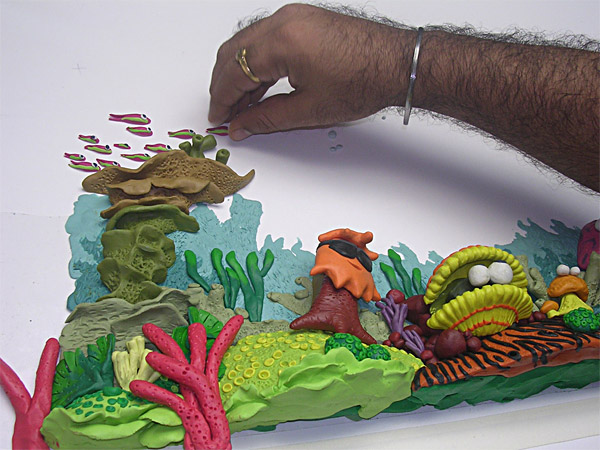
Tell us about the technique.
I use my own technique which I like to call embossed clay illustration. It is different from typical clay animation, as the clay figures don’t stand upright but are laid out flat on a smooth surface. It is technically easlier to animate in this manner as it requires less planning than when armatures are used. Light is used to give the almost 2D surface the look and feel of a three dimensional one. The illusion of depth comes from the play of light and shadows. But the light has to be planned carefully or else it will throw unnecessary shadows. This steals the volume. So the challenge is in creating a model that looks three dimensional under the camera. You have to cheat a lot. When you look at the model by itself, its shape looks odd but when looked at through the camera lens, it is perfect. The camera is set up to film the animation from the top. We used 2 cameras - a web cam to check the animation frame by frame and another Canon digital SLR for capturing the final hi-res stills.
This is a technique you have developed on your own?
Yes. I haven’t seen anyone else use this technique. This is just the third time that I have attempted to use it. Before this I had tried a few clay illustrations for my own work and later to create “Happy Planet”.
What other challenges did you face during animation?
A very important thing while animating is to be able to maintain correct timing. Each element has a different speed and a unique style of motion. Sometimes, one shot has 20 to 25 items moving. For example, there was a scene with 2 groups of fish. One small mistake means everything needs to be redone. To add to that, there was a very tight deadline. But timing is something that you learn with experience. There were no cuts in the 3 minute sequence. Sometimes we used morphs, other times there were pans, but the flow is always continous. It was physically stressful but creatively most satisfying. I thoroughly enjoyed animating it.
Tell us about the title sequence.
The title where the name of the film Taare Zameen Par morphs from English to Hindi to Urdu, the movement of the octopus, fish and parrot was shot against a blue, red and then a green screen placed under the glass. The team at Tata Elxsi composited those shots.
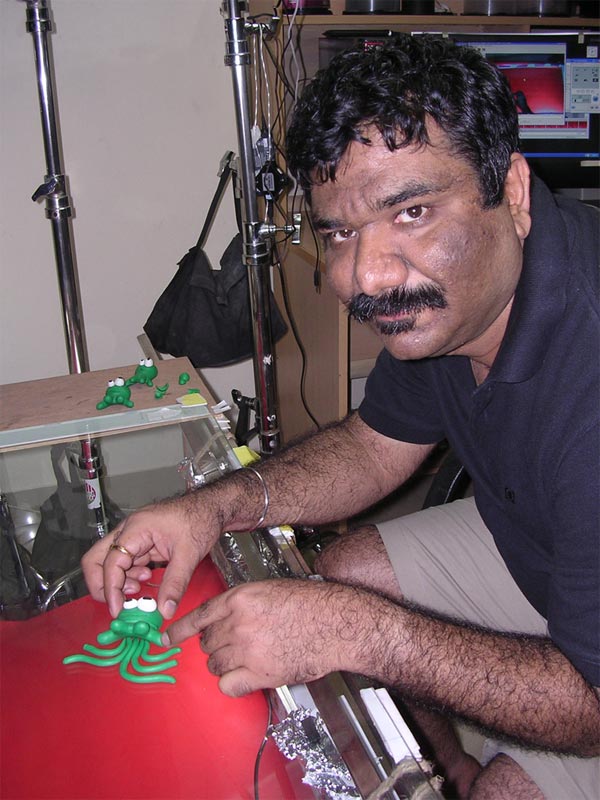
Could you please share some clay animation tips and tricks with us?
Sure. For certain scenes, instead of modeling directly on the table, we made replacements beforehand and used them to speed up the actual animation process. But in other scenes, like in the scene where the peacock turns into a flower, we had to sculpt on the table. Everything was animated on one layer rather than multiple glass layers as is generally used for this technique. We left very little work for post-production. Only the bee’s and bird’s wings were created using Photoshop. The scene where the Hippos is entering the water also needed to be done differently.
What about the music and the soundtrack?
Luckily the music was superimposed later or else it might have been even more tedious to animate.
What else would you like to tell our readers?
Work very hard and have a passion for the work that you do - it could be anything. Enjoy your work, don’t just think about the money, it will follow if you do your best. Keep your eyes open and try to learn new things, experiment, try to be perfect and stick to your deadlines. Love your work and teach others! I think that is a lot of advice. Bahut ho gaya!! Enjoy the movie on the big screen.
Kerala Cartoon Academy, cartoononnews.blogspot.ru



































